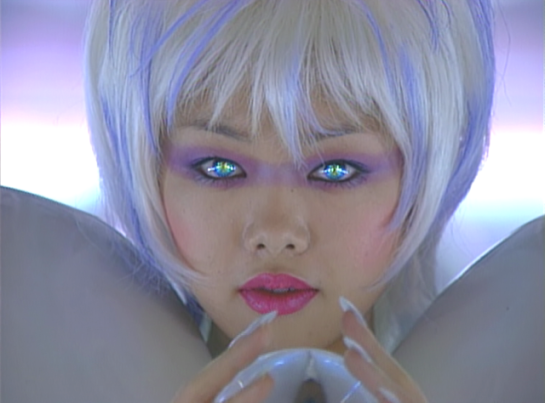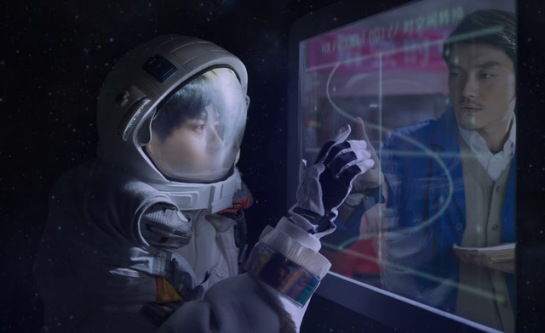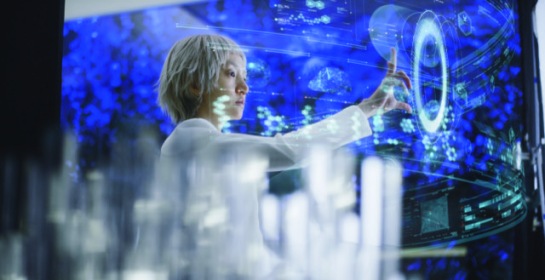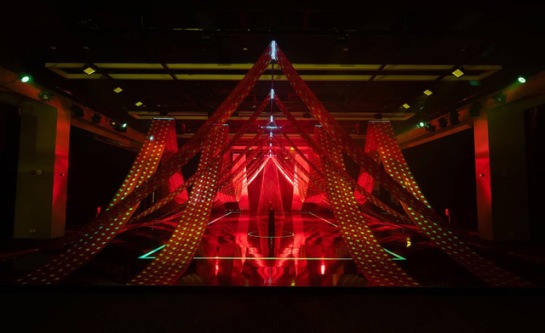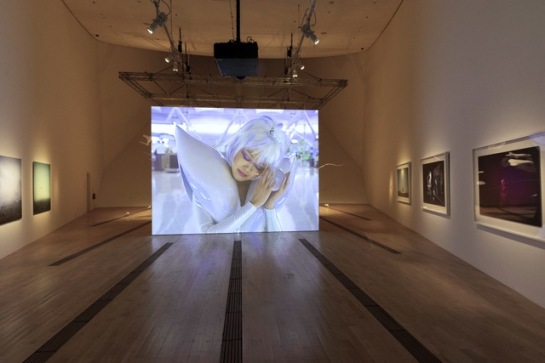New Eden: Science Fiction Mythologies Transformed
New Eden: Science Fiction Mythologies Transformed
An exhibition co-curated by Honor Harger
3 March 2024
It is the last few days of the run-time of an exhibition at ArtScience Museum, which has been very important to me.
New Eden: Science Fiction Mythologies Transformed (21 October 2023 – 3 March 2024) is a major new contemporary art exhibition that shows how artists from Asia are addressing science fiction, dream worlds and fantastical realities in their work. New Eden features 24 Asian women artists and collectives, including some of the biggest names working contemporary art globally, such as Mariko Mori, Cao Fei, Patty Chang, Sputniko!, Lee Bul, and Shilpa Gupta. It is curated by me, Gail Chin, Joel Chin, and Adrian George from ArtScience Museum.
The contemporary art world has had a fascination with science fiction in recent times, with many shows on the topic being presented in museums around the world. But rarely is science fiction approached from the perspective of Asia and through the work of women. New Eden makes connections between Asia and the West. Popular science fiction concepts such as parallel universes, interdimensional travel, and transcendence, are notions that are also deeply rooted in Asian philosophy and spirituality. New Eden draws lines between these discrete cultural traditions, suggesting that some science fiction tropes could have their origins in Asia.
The website is here: https://www.marinabaysands.com/museum/exhibitions/new-eden.html
The exhibition guide is here: https://www.marinabaysands.com/museum/exhibitions/new-eden/exhibition-guide.html
Here’s the curatorial essay we wrote for the show:
Intersecting Narratives:
The Confluence of Science Fiction and Asian Spirituality in Contemporary Art Practice
By Gail Chin, Joel Chin, Adrian George and Honor Harger
An introduction to New Eden: Science Fiction Mythologies Transformed
ArtScience Museum
21 October 2023 – 3 March 2024
New Eden: Science Fiction Mythologies Transformed, curated by ArtScience Museum, is an interdisciplinary exhibition that delves into the intersectionality of science fiction and Asian spiritual philosophies through the creative praxis of 24 Asian women artists and collectives.
Structured around eight thematic chapters – Paradox of Paradise, Words and Worlds, New Nature, Ways of Folding Space, Crafting New Worlds, The Monstrous Feminine, New Myths, and In a New Light – the exhibition weaves together narratives found in the Western literary and cinematic genre of science fiction and ideas inherent in Eastern spiritual traditions that have evolved over centuries and millennia. It finds synchronicities between speculative ideas in science fiction and ontological concepts embedded in Asian spiritual frameworks such as Buddhism, Hinduism, Taoism, Shintoism, and the diverse belief systems of Southeast Asia.
Both speculative fiction and Eastern spiritual doctrines engage with the fundamental questions of consciousness and the nature of existence. In science fiction, the exploration of concepts such as simulated realities or alternate dimensions, resonate with ideas found in Eastern philosophies that question the inherent illusion of our perceived reality. Within New Eden, artists such as Cao Fei and Fei Yi Ning astutely address these complex questions about reality, memory and knowledge.
Cao Fei, Nova 17, 2019 Film Still Courtesy of the artist, Vitamin Creative Space and Sprüth Magers
Ideas of transcending human limitations and achieving higher states of being are common in both realms. In science fiction, this aspiration manifests in concepts such as post-humanism or the digital uploading of human consciousness, mirroring the timeless quest for spiritual enlightenment epitomised in Buddhism or the spiritual liberation known as ‘moksha’ in Hinduism. The universal human yearning for transcendence, whether via the avenues of scientific innovation or spiritual enlightenment, is addressed by many of the artists featured in New Eden. The Words and Worlds chapter examines these parallels through the juxtaposition of historical artefacts from a range of Asian countries, cinematic science fiction and an artwork by Shilpa Gupta.
Installation view of Words and Worlds chapter, ArtScience Museum.
Both domains emphasise the fundamental interconnectedness of all living entities. Shintoism, a Japanese religion, focuses on a deep connection with nature, and the belief in ‘kami’, spirits that inhabit the elements. Science fiction frequently explores the intricate relationship between humanity and the natural environment, envisioning scenarios in which technology and nature seamlessly intertwine. This convergence can be seen in works that feature sentient ecosystems, living planets, or bioengineered organisms, a topic explored by artists like The House of Natural Fiber and Chok Si Xuan in the New Nature section.
The House of Natural Fiber, Galactica V.2 Dharma Garden, 2023 Mixed media installation
In Taoism, an ancient Chinese philosophy and spiritual tradition, there are intriguing parallels to the science fiction concept of travelling in space and time. Taoist texts describe the ability to travel immense distances in the blink of an eye. Taoist philosophy includes the idea of “warping” or “folding” space, suggesting that through spiritual cultivation, individuals can manipulate the very fabric of reality itself, altering distances and connections between entities. In the realm of science fiction, folding space is akin to the idea of wormholes or other spatial anomalies that offer shortcuts for faster interstellar travel. These notions are at the centre of the Ways of Folding Space section of the exhibition, manifested in the work of South Korean artists, Moon and Jeon.
Moon Kyungwon and Jeon Joonho, The Ways of Folding Space and Flying, 2015 Four channel HD video, colour, sound. Courtesy of the artists.
The exhibition also establishes a dialogue between Southeast Asian folklore, a narrative form preoccupied with cultural identity and the ramifications of modernity, and speculative fiction, a genre that scrutinises contemporary life. Southeast Asian folklore is rich with mythical beings like the ‘Naga’, ‘Garuda’, and ‘Aswang’ and astral spirits like the ‘Pontianak’. Science fiction often features creatures from other worlds, perhaps drawing inspiration from these allegorical entities. The blending of science fiction and folklore gives rise to imaginative forms of storytelling, which is the focus of The Monstrous Feminine chapter of the exhibition, featuring the work of Club Ate, Etsuko Ichihara and others. In other sections of New Eden, artists like Saya Woolfalk and Nguyen Trinh Thi fuse the fantastical with the unsettling, leveraging their cultural histories to comment on present-day challenges.
Saya Woolfalk, Cloudscape, 2021 Four channel video installation, colour, sound
Science fiction often includes elements of mysticism, echoing the epistemic inquiries found in Taoism, Hinduism, and Shinto rites of passage. The exhibition’s concluding chapter, In A New Light, showcases Mariko Mori’s seminal work, Miko No Inori, a piece that materialises these complex intersections. Positioned in dialogic tension with Mori are installations by Lee Bul and Astria Suparak, who interrogate the sociopolitical structures of science fiction.
Lee Bul, Untitled, 2003, Polyurethane, enamel paint, stainless steel and aluminum wire.. Collection of National Gallery Victoria.
The exhibition focuses on the work of Asian women artists and collectives, a decision driven by two critical imperatives. First, the 24 artists in New Eden engage with global themes that have made them influential figures in the art world. Artists like Patty Chang and Cao Fei are known for their thought-provoking social commentary, using art to examine gender, urbanisation, and technology’s impact on society. Sputniko!, Anne Samat and Soe Yu Nwe interweave indigenous Asian motifs with contemporary sensibilities, a gesture that destabilises conventional art narratives and invites pluralistic engagement. Secondly, the exhibition confronts the masculine bias of science fiction, historically a Western, male-dominated genre, with women often portrayed in highly stereotypical ways. By foregrounding women and diverse voices, New Eden reconfigures hegemonic narratives, embracing more egalitarian forms of storytelling and artmaking. Science fiction operates as a speculative canvas, delineating possible futures which can be socially and politically influential. By embracing polyphonic perspectives, New Eden advocates for futures that more genuinely reflect the heterogeneity of contemporary society.
Sputniko! and Napp Studio & Architects, Red Silk of Fate – The Shrine, 2022 Handwoven silk Courtesy of the artists.
The overlaps between speculative fiction and Eastern spiritual belief systems provide fertile ground for creative storytelling and philosophical exploration, highlighting how human fascination with the unknown and our quest for understanding can bridge the gap between science and spirituality. New Eden shows how art can forge connections between seemingly disparate realms. The unexpected confluence between science fiction and ancient philosophy inspires contemplation about the nature of our existence and our place of the universe. The artists within New Eden also challenge our preconceived notions about what we see in the science fiction genre and show that by drawing on their own Asian traditions, new narratives, aesthetics, and creative propositions can be found.
Honor Harger, October, 2023
Installation view of In a New Light chapter, ArtScience Museum
